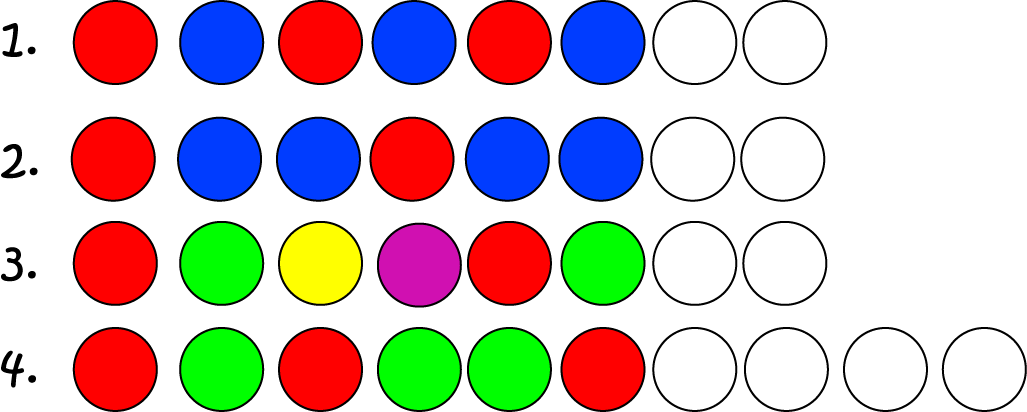Prekinder to Grade 2 Mathematics
Patterns
Patterns

Patterns in Mathematics
Mathematicians are very interested in studying patterns and their symmetries. Let's have a look at a few simple patterns of the sort that mathematicians might be interested in.
Patterns with Colours
Here's a simple pattern made out of coloured circles:

Two red circles are followed by two yellow circles. Then there are two red circles, and then two yellow circles again. The pattern keeps going just like this, with alternating pairs of red circles and yellow circles. We can easily predict what the next few elements of the pattern will be. First, we need to add a yellow circle to complete the pair of yellow circles. Second, there would be two red circles. Then two yellow circles, and so on.
If you have lots of counters, stickers or lego bricks at home, you can play with them and build patterns like this yourself.
Examples
Why don't you see if you can predict the future? Have a go at working out how to continue the following patterns. How should you colour in the empty circles at the end of each line? The answers are below, but no peeking! Cover them up while you work on the patterns.

Answers:
Here's how I thought we should continue the patterns. Do you agree?

Patterns with Shapes
We can also use shapes to form different patterns. Here's an example to start with:

Do you notice part of the pattern that is repeated over and over again to form the whole pattern? There's a red circle, followed by a blue star, followed by a yellow hexagon. If you made a stamp containing those 3 shapes in that order, you could stamp it over and over again on a piece of paper and make a pattern as long as you like. Of course, you could also draw the shapes in a paint program on your computer and do the same thing using cut and paste!
Examples
Why don't you see if you can predict the future? Have a go at working out how to continue the following patterns. What should you use to fill in the empty squares at the end of each line? Look for a small part of the pattern that is repeated over and over again to form the whole pattern. The answers are below, but no peeking! Cover them up while you work on the patterns.

Answers:
Here's how I thought we should continue the patterns. Do you agree?

Number Patterns
We can also form patterns out of numbers. You can read about lots of interesting patterns in the article about number patterns, but let's just have a look at a few simple examples.
Example 1
Example 2
Example 3
Fibonacci numbers. It was invented to work out how quickly rabbits breed.
Building your own number patterns
You can use just about anything you can find around the house or backyard to make patterns. The family cat might not be too impressed if you tried to make a pattern out of its whiskers, but things like coins, buttons, blocks, gum nuts, peas or toothpicks shouldn't cause too much trouble. Well, maybe the peas aren't such a good idea!
Here's an example of a pattern built out of blocks:

To find out more about building your own number patterns, read the article on building your own patterns.
Conclusion
Patterns can be found just about anywhere. Why not have a play and see if you can come up with some interesting patterns of your own? Just don't tell mum and dad that I said it was OK to play with your peas... That can be our little secret.
Description
This mini book covers the core of Math for Foundation, Grade 1 and Grade 2 mathematics including
- Numbers
- Addition
- Subtraction
- Division
- Algebra
- Geometry
- Data
- Estimation
- Probability/Chance
- Measurement
- Time
- Money
- and much more
This material is provided free of cost for Parent looking for some tricks for their Prekinder, Kinder, Prep, Year 1 and Year 2 children
Audience
Grade 1/Year 1, Grade 2/Year 2, Prep, Foundation, Kinder and Pre-Kinder
Learning Objectives
These lessons are for kids aged 4-8 with the core objective to expose their brains to concepts of addition, subtraction, division, algebra and much more.
Author: Subject Coach
Added on: 6th Apr 2018
You must be logged in as Student to ask a Question.
None just yet!